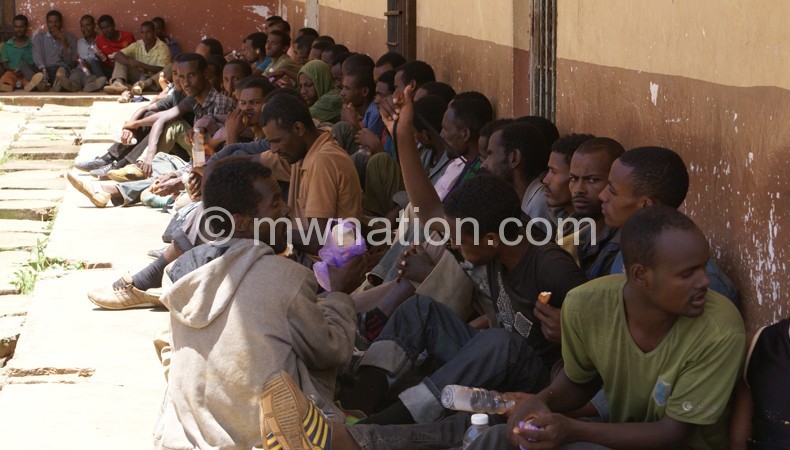Solving the Ethiopian puzzle
Migration experts say Malawi lies on the South Road, an unchartered route for irregular migrants from the Horn of Africa in their trek to South Africa for the better life or en route to even much better life in Europe or America. In fact, the International Organisation for Migration (IOM) estimates that 20 000 people are going south from the region, especially Ethiopia every year.
When the undocumented migrants are caught in Malawi, they serve prison sentences or fined if convicted. After serving the sentences, they are supposed to be repatriated. Yet, recently Prisons Inspectorate chairperson, a judge of the High Court of Malawi, Ken Manda said some of the Ethiopians who had been tried, convicted, fined or finished their sentences were still languishing in local prisons.

That corroborated IOM findings which pegged the figure at 387 as well as Medecins Sans Frontieres (MSF), which says the condition of Ethiopians at Maula Prison in Lilongwe is degrading. IOM last week bought air tickets to repatriate 36 of the Ethiopians. It takes $500 (about K285 000) to repatriate one migrant.
TasfayaLanago, 18, left Ethiopia in December 2014 and upon arrival in Malawi, he was arrested for illegal entry in February 2015. Previously, he had tried life in South Sudan, Kenya and Tanzania. Malawi was his next point of call before going to South Africa.
“I had stayed 15 days at Dzaleka. I raised enough money and got on a truck heading to South Africa. We were caught by police in Dedza who brought us to Maula. For nine months now, immigration always say: ‘You will be repatriated tomorrow! Tomorrow! Tomorrow,” says Lanago in an MSF June 2015 file.
Lanago, according to MSF, faces congestion, inadequate food, language troubles and illnesses. These, as Malawi Prisons commissioner Kennedy Nkhoma attests, are not problems peculiar to the Ethiopian migrants, as other inmates face the harsh conditions of congestion, minimal medical care, improper nutrition and other problems.
Chief immigration officer MasaukoMedi wonders: “Why should hell be raised about irregular migrants languishing in Malawi jails, when about 1 700 Malawians are also suffering at the Lindela Repatriation Camp in South Africa?
“We have reports that four Malawians died there. To deal with this problem, we need a multilateral approach. It is not a problem affecting one country.”
Last year, South African’s Human Rights Commission (SAHRC) said 44 percent of irregular migrants at Lindela were Malawians, topping the list of those held. The report said the migrants faced health and human rights abuses.
IOM southern Africa regional liaison and policy officer Yina Yitna said the problem is not merely holding irregular migrants when they are caught pending repatriation. The problem, as is the case with Malawi, is incarcerating them with criminals. There have to be alternatives.
“Malawi has to make sure that hasty detection is made. Before decisions on detention are made, it must be noted whether they are mixed migrants or victims of human trafficking. Zambia has made good progress on that,” says Yitna.
According to him, Malawi can consider the alternative of integrating the migrants into the Malawi community, if voluntary and assisted repatriation fails.
Boris Mulengu of the legal and prosecutions unit in Zambia’s immigration department agrees with Yitna that Malawi can learn a lot from the western neighbour on dealing with the Ethiopian migrant puzzle.
“Before we amended our migration law, we used to have similar problems. As a matter of fact, the influx is higher in Zambia. In Kabwe alone, we have about 145 irregular Ethiopian migrants. The most efficient means we have used is to empower immigration, police, health and even religious leaders to identify who they really are once they are caught,” says Mulengu, adding there are alternatives, such as community service and timely repatriation.
Southern African Litigation Centre (Salc) executive director KaajalRamjathan-Keogh suggests Malawi can adopt the Community Assessment and Placement (CAP) model from the International Detention Coalition (IDC), which provides alternatives to detaining irregular migrants. This, she says, can be done following a five-step procedure.
“First, authorities must presume detention is not necessary. Then, they must screen and assess the migrant. Conditional alternatives like integration in communities and apply conditions in the community while monitoring them. Detention should be the last resort,” says Ramjathan-Keogh.
This, she says, is cheaper, as keeping migrants in jail drains the national coffers as they have to be fed, while government officials need money to visit migrants.
Malawian authorities agree the first step is to formulate a new immigration policy that will look into the isssues holistically. This is a similar approach to the Zambian model where government departments—immigration, police, prisons, health, social welfare and others—work together to solve the migration enigma.
While all these processes are underway, as Yitna would have it, it is necessary that lessons must be taken back to Ethiopia, to raise awareness to its 96 million strong population that irregular migration only leads to more misery. That, he says, can be done by former migrants telling their stories.
Ask Lanago what he thinks about travelling out of Ethiopia without proper documentation and he will definitely tell you: “I would never do that again. This prison is terrible. I thought Africans were all brothers, but now, I see. We don’t have food, no clothes or soap. They are killing us.”





